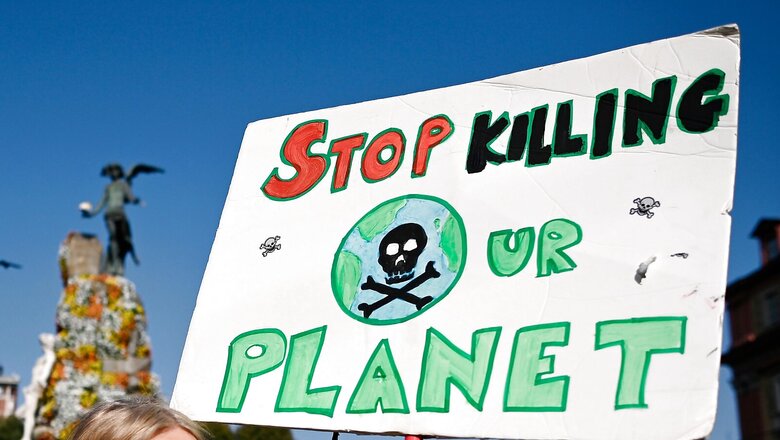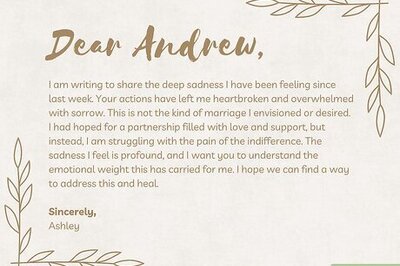
views
The world’s eyes are on the upcoming gathering in Glasgow, the biggest climate conference since the Paris summit, which is being seen as crucial in setting worldwide emission targets to slow global warming. Around 20,000 heads of state, diplomats, and activists are expected to meet in person from October 31 to November 12, to set new targets for reducing greenhouse gas emissions caused by the burning of coal, oil, and gas. The conference is held every year, but this year is especially important because scientists say nations must make an immediate, sharp shift away from fossil fuels if they are to avoid the most catastrophic effects of climate change.
Focus is also on India’s stance for the COP26, which is among the countries – China, Australia, Russia – that have yet to make new pledges to cut their pollution.
The goal is to prevent the average global temperature from rising more than 1.5 degrees Celsius compared with levels before the Industrial Revolution. That’s the threshold beyond which scientists say the dangers of global warming — such as deadly heat waves, water shortages, crop failures and ecosystem collapse — grow immensely, explains a report by Lisa Friedman in the New York Times.
Meanwhile, only a few wealthy countries have set aside funds to assist poor and vulnerable countries in dealing with the consequences of climate disasters that they have done little to cause.
What is COP26?
COP stands for “Conference of the Parties.” In diplomatic parlance, the parties refer to 197 nations that agreed to the United Nations Framework Convention on Climate Change at a meeting in 1992. That year the United States and some other countries ratified the treaty to combat “dangerous human interference with the climate system” and stabilize levels of greenhouse gas emissions in the atmosphere.
This is the 26th time countries have gathered under the convention — hence, COP26.
What happened the previous 25 years?
The first COP was held in Berlin in 1995, after a critical mass of nations ratified the climate convention. It was a milestone and set the stage for the Kyoto Protocol in two years later, which required wealthy, industrialized nations to curb emissions.
That accord had its problems. Among them, the United States under former President George W. Bush rejected it, citing the fact that it did not require China, India and other major emerging economies to reduce their greenhouse gases.
Fast forward to 2015. After more than two decades of disputes over which nations bear the most responsibility for tackling climate change, leaders of nearly 200 countries signed the Paris Agreement. That deal was considered groundbreaking. For the first time, rich and poor countries agreed to act, albeit at different paces, to tackle climate change.
The United States withdrew from the Paris Agreement under former President Donald Trump but rejoined under President Joe Biden.
While leaders made big promises in Paris, countries have not done enough to stave off the worst impacts of climate change, which brings us to COP26 in Glasgow, where the pressure is on for leaders be more ambitious.
When is COP26?
The conference runs from October 31 through November 12.
Where is COP26?
The meetings will be held at the Scottish Event Campus, Glasgow’s largest exhibition center. In addition to the more than 20,000 people expected to attend the formal talks and side events, large marches are expected around the city. Saturday, Nov. 6, has been designated the Global Day for Climate Justice and advocacy groups are expecting about 100,000 protesters.
About 10,000 officers a day are planning to patrol the event, and Scottish law enforcement officials have promised that their approach will be “welcoming, friendly and proportionate.”
What is India’s Stance So Far on Cop26?
According to a report in the Times of India, India will not commit to the 2050 ‘net zero’ goal, and, along with China — despite intense friction over border issues — and other developing countries, will tell the wealthy nations to aim for carbon neutrality much earlier than mid-century, taking into account their own cumulative historical emissions. The report states that India will emphasise the importance of the developed world adhering to the principle of shared but differentiated responsibility, as well as the need to deliver on climate change mitigation finance.
The report, however, states that India may make additional commitments or announcements, taking into account its overachievement of 2030 pledges and ambitious renewable energy goals of 450 GW, and aligning it with the 2047 timeline, coinciding it with 100 years of independence.
The Union cabinet will next week approve India’s formal stand at the upcoming session.
Who will attend COP26?
Biden said recently that he will “be there with bells on.” He is among about 100 heads of state who have said they will attend, including Queen Elizabeth, Prime Minister Boris Johnson of Britain and Nicola Ferguson Sturgeon, the first minister of Scotland. Among those who so far have not RSVP’d in the affirmative: President Xi Jinping of China, the world’s largest emitter.
Thousands of diplomats from nearly 200 countries will conduct the nuts and bolts of the negotiations, while business leaders, academic experts and activists, including Greta Thunberg, plan to monitor the proceedings and in many cases will advocate the most ambitious outcome.
What will happen at COP26?
The UK and UN hosts have said they want to “keep hope alive” of constraining global temperature rise to under 1.5 degrees Celsius.
Meeting that goal means all countries must commit to cutting emissions faster and deeper than they already are doing. There is also an expectation that wealthy countries will significantly boost financial support to help the most vulnerable nations adapt to the impacts of warming and build economies that don’t depend on fossil fuels.
What is at stake at COP26?
For every fraction of a degree of warming, scientists say, the world will see more intense heat waves and drought, and more deadly floods and wildfires. Humans have already heated the planet by roughly 1.1 degrees Celsius, or 2 degrees Fahrenheit, since the 19th century.
Countries have less than 10 years to reduce emissions enough to keep the planet below 1.5 degrees of warming. So if leaders don’t commit to bold steps now, when so much global attention is focused on Glasgow, many fear the world will barrel toward dangerous levels of warming.
So far 17 countries and the European Union have made new pledges, including the United States. Biden has said that America will cut emissions 50% to 52% below 2005 levels in the next decade. As of now, though, few policies are in place to make that happen.
Whether other countries come on board, and whether the United States can actually make good on its promise, will determine the trajectory of the planet.
What COVID safety measures are being taken at COP26?
The annual summit was delayed last year because of the pandemic. Despite calls from environmental organizations to delay again, organizers have been adamant about holding this year’s event in person. The British hosts have offered to help any delegates who need a COVID-19 vaccination obtain one, but they are not mandating that attendees be vaccinated. Instead they will require that delegates show a negative coronavirus test every day in order to be admitted to the conference center. Attendees from countries that Britain has placed on its “red list” because of high infection rates must quarantine upon arrival.
With inputs from New York Times.
Read all the Latest News , Breaking News and IPL 2022 Live Updates here.
















Comments
0 comment